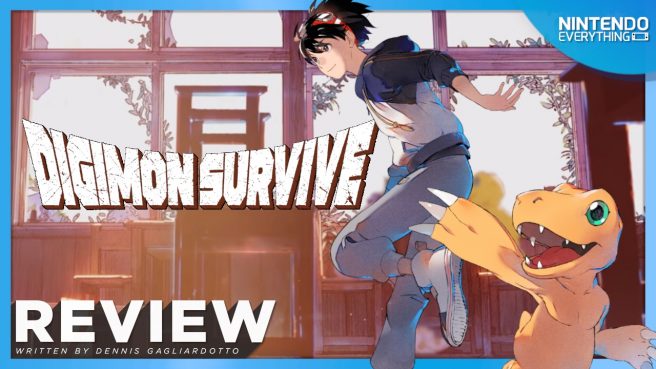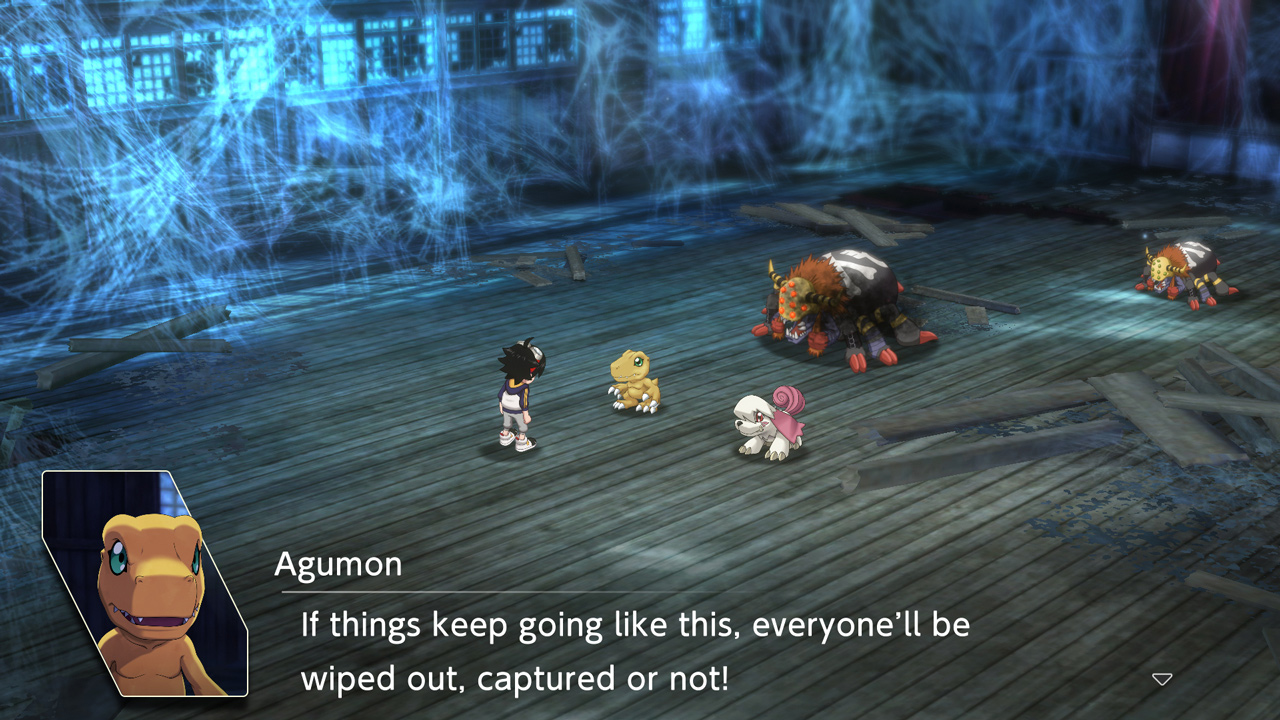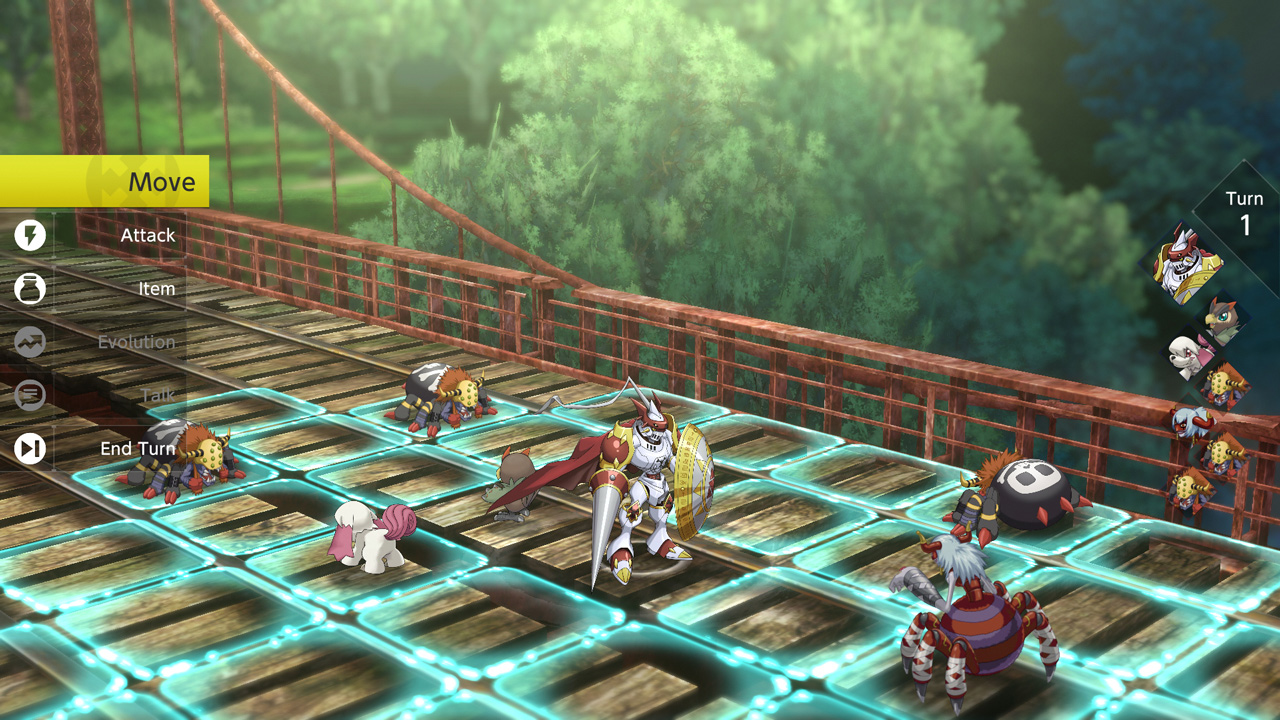[Review] Digimon Survive
System: Switch
Release Date: July 29, 2022
Developer: Hyde
Publisher: Bandai Namco
From the Digimon tri. films to the dark Cyber Sleuth games, Digimon has seen renewed life in recent years with its new focus and emphasis on more somber tones and older, relatable characters. It’s no surprise then that Digimon Survive would once again continue this new vision and provide what is interestingly its most thought-provoking entry yet. The game features a deep and rich story, and it’s all implemented within a tactical RPG that’s rewarding, engaging, and worthy of the Digimon name.
Digimon Survive sees an older cast of teens embark on a school trip, but not before news spreads of natural disasters and events taking place close by that are equal parts mysterious and concerning. While investigations are underway by local authorities, the field trip continues as planned, leading the ensemble of characters to visit blooming sakura trees and local temples. However, once a select few find themselves lost, they come into contact with others who are being attacked by Digimon, and with the help of Agumon save their classmates.
Everything from here on out serves as a means of survival as they adapt to a new world of Digimon and dangers that lurk in every corner. Throughout the roughly 30-40 hour playthrough, a multitude of decisions will be made that can impact any number of things – including the ending – and this system of affinities, bonds, paths, and more can even see characters and the like have their stories prematurely end. Digimon Survive is one of its darkest takes on stories the franchise has seen, but it’s not just dark for the sake of being dark, edgy, or appealing, and utilizes the tones and narrative structure in a respectful way that keeps dialogue, events, and the sort incredibly captivating and emotionally gripping.
There’s a lot about Digimon Survive that will feel familiar to those who frequent themselves with visual novels and strategy RPGs, and I couldn’t help but feel like the game was inspired by the likes of both the Utawarerumono series – a brilliant strategy RPG that emphasizes the visual novel side of its hybrid genres – and XBLAZE Code: Embryo/Lost: Memories with how the visual novel segments are polished, animated, and sequenced in a fluid manner rather than the standard static illustrations that are par for the course for the genre. The visual novel segments are large, and this is especially prevalent for the beginning portion of the game where it eases players into the story, but eventually, the battle segments will take more of a spotlight as more hours get put in and the story reaches its climax.
Unlike a lot of other visual novels, however, there is a layer of interactivity within these segments as well, and it keeps Digimon Survive engaging throughout. There’s a great story to experience and read through, as well as fantastic battle mechanics in its SRPG sections, but there’s also a point-and-click element to it as well where players can freely highlight and interact with objects or people in a scenario to gather more information, which could also lead to changes in battle and how the bonds from person to person will function and affect story outcomes. Also, having a map to move from various areas you’ve come into contact with and related to the story at that moment gives a sense of freedom as well. This plays out similarly to, say, Famicom Detective Club or the Ace Attorney series in which a cursor will be displayed to select objects of interest.
All of this is presented in one of the most stylish user interfaces seen in the Switch’s library so far and arguably in years for gaming as a whole, almost taking an approach similar to Atlus or Spike Chunsoft in which their games tend to have menus that feel very much part of the experience rather than a separate entity of the game altogether used simply for pausing and accessing options. This gives a hugely appreciated level of finesse and panache to an already striking title, with menus and overlays conveyed in a style representative of phone screens. It is also done with slick iconography to describe each panel being shown. Even outside of menus, its finesse is showcased all around, with a clean user interface seen even through standard dialogue segments and moments where extra mechanics like using your camera to discover hidden distortions to keep a consistency throughout.
Of course, Digimon Survive and Digimon as a whole wouldn’t be what it is without its battles. When these portions do come up, they’re just as enjoyable as the rest of the game, providing a slightly different but still recognizable art direction that lends itself well to both handheld and TV modes despite the much smaller font and assets while on the battlefield. Traditional mechanics seen within the genre are all set in place here and work as expected, with tiles spread throughout for movement, and attacks all having a different area of effect. The game adds layers of depth within these mechanics that give more personality to the Digimon themselves while managing to still keep that vibe of Digimon continuing – it doesn’t simply feel like a reskin of any other strategy RPG. The core functions are there, but the fact that everything can be done on the fly is massively appreciated and saves time spent before battle for preparation. Sometimes you’re happy with a setup, or realize last minute or after a certain turn that there’s a certain build that may be more advantageous; Digimon Survive allows at any point in the battle to be able to head to the menu and equip/unequip items, change difficulty, and of course handle the one thing that stands out the most: digivolving. All of this provides a fantastic experience that feels pure and true to Digimon, and the inclusion of such a great cast of characters that build these bonds with not only each other but their partner Digimon as well can, at many times, provide heartfelt and emotional moments that you’d be hard-pressed to find in other titles Digimon typically find itself compared to.
Admittedly, however, these battles do eventually reach a level of shallowness due to repeated enemy types, and special attacks can feel somewhat limited. This can vary from player to player, however, and while the depth is there, after so many hours of playing the game once you’ve gotten comfortable with the mechanics, a lack of new systems and strategies eventually leads to the feeling of repetition that can somewhat hinder the experience. This is a primary issue with the battling system, however, and considering this is mostly a visual novel, it’s forgivable more often than not as it’s already an incredibly engaging experience regardless.
While Digimon throughout its entire run has seen ups and downs and delved into myriad genres in gaming that have varied in terms of quality, I think it’s safe to say that for the last couple of years, despite a slower release schedule, the series has introduced itself into a safe space of quality titles that make them end up being some of the best each genre it participates in has to offer. However, because of the heavy visual novel element, some players not used to the genre may feel alienated since it is considered more niche. But if you tend to play large amounts of JRPGs in general, there’s no reason extensive dialogue should be cause for concern, and Digimon Survive should be considered more often than not by fans of both the series and those looking to dive into something new and refreshing. It will take a bit of patience, however, as the first hour or two can be a bit sluggish while the game introduces players to the mechanics and set up a story that could’ve been established after its opening cutscene. At the very least, its character development is extremely well done, and it’s quite frankly one of the best stories Digimon has ever had.
The Verdict

Digimon Survive is a wonderful and unique game that takes some of the best ideas from the most high-quality visual novels and merges them with a proper Digimon spin on strategy RPGs to create what is arguably one of the biggest standout titles in the series’ history. It may have been a long wait of multiple delays and long periods of silence to get here, but it’s been well worth the wait as the game has a production quality that shines through every frame of its visual novel segments with excellent animation, panning, transitioning, and illustrations that make it a candidate for being one of the most beautiful games on Switch. Its strategy RPG gameplay portions also feel cinematic and echo the more strategic sides of Digimon’s natural battles that we’ve seen in various episodes and films throughout its two-and-a-half-decade run, and though they may seem fairly basic on the surface at first glance, Digimon Survive provides a deep and thoughtful system in place that’s true to the mechanics and lore while also having sequenced events within to keep the battles engaging and immersive.
Digimon Survive copy provided by the publisher for the purposes of this review.



